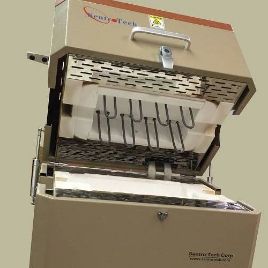
Different Types of Tube Furnaces
There are different types of tube furnaces, and each caters to a broad spectrum of industrial needs and is uniquely designed for specific applications. The rotary tube furnace stands out for its dynamic operation, ideal for continuous processing and heat treatment of powders. On the other hand, a horizontal tube furnace offers easy access and uniform heating, perfect for research and small-scale production. The vertical tube furnace is known for its space-saving design and efficient heat distribution, a top choice for high-temperature sintering. In this section, we discuss these diverse types, highlighting their distinctive benefits and applications for each.
Vertical Tube Furnace
A vertical tube furnace is designed to offer high-temperature heating in a vertical orientation. This type of furnace provides precise temperature control, uniform heating and efficient energy usage. Its vertical design is particularly useful for applications where space is a constraint or where the process benefits from a vertical setup.
- Applications: A vertical tube furnace is commonly used in applications requiring controlled heating and cooling rates, such as in material testing, thermal processing and chemical reactions. Its design is favorable for processes where the sample needs to be dropped into the furnace from the top, making it suitable for certain types of chemical and physical experiments.
- Benefits: Their vertical configuration means a smaller footprint compared to horizontal furnaces, making them ideal for laboratories with limited space. Additionally, the vertical setup can aid in certain processes where gravity assists in the experiment or manufacturing process, ensuring even distribution of heat and materials.
Horizontal Tube Furnace
A horizontal tube furnace is versatile and commonly used in many laboratory settings. It offers uniform heating across the tube length and can accommodate various tube sizes. The horizontal orientation is beneficial for processes that require a uniform temperature zone along the length of the tube.
- Applications: Ideal for annealing, material testing and chemical processing, a horizontal tube furnace can be used in applications where samples need to be observed or rotated during processing. It's also suitable for applications where long, continuous tubes are required.
- Benefits: The horizontal design of these tube furnaces allows for easy placement and removal of samples and is ideal for experiments that require manipulation or observation during the heating process. The uniform heating capability ensures consistent results, which is critical for research and quality control in laboratory environments.
Rotary Tube Furnace
A rotary tube furnace incorporates a rotating mechanism, allowing the tube to turn during operation. This rotation ensures a more uniform heat distribution and mixing of samples. These tube furnaces are ideal for continuous processing and can handle both small and large sample volumes.
- Applications: Rotary tube furnaces are particularly useful in applications such as powder metallurgy, material blending and chemical reactions where uniform heating and continuous mixing are essential. They're also used in industries that require the processing of granular or powdery materials.
- Benefits: The rotating action in these furnaces provides a uniform temperature distribution and prevents the settling of samples, which is crucial for consistent processing and analysis. The rotation also enhances the efficiency of heat transfer, leading to faster processing times and more uniform results.
Each of these different types of tube furnaces offers unique advantages tailored to specific applications, providing versatile and efficient high-temperature solutions for a wide range of industrial and research needs.
Discover the Sentro Tech Advantage: Tube Furnaces of Unmatched Quality and Customization
Choosing a Sentro Tech vertical, horizontal or rotary tube furnace means opting for unparalleled quality and customization. Our tube furnaces stand out for their robust build, reliability and longevity, ensuring that your investment is sound and sustainable. There are plenty of customization options, allowing your furnace to meet specific industrial and laboratory requirements. Whether it’s adjusting temperature ranges and dimensions or adding unique features, Sentro Tech works closely with clients to meet precise specifications. Explore Sentro Tech today – then we'll talk about your specific furnace requirements.
Contact UsFrequently Asked Questions About Tube Furnaces
Whether you're in the market for a rotary, horizontal or vertical tube furnace, it's likely you have a question or two. We've answered a few of them below, but please reach out if you'd like more information on this topic.

What Is a Laboratory Tube Furnace?
A laboratory tube furnace is a heating device designed for precise temperature control and uniformity. It's used for heat treatment of materials, crystal growth and other applications requiring consistent heating.
What Is the Main Benefit of Tube Furnaces vs. Chamber Furnaces?
Tube furnaces are better suited for processing smaller samples, thanks to their smaller volume capacity and quick heat-up rates. They also allow for a controlled atmosphere around samples, which is beneficial for maintaining purity and preventing contamination.
What Is the Uniform Length of a Tube Furnace?
The uniform length is the area within the furnace where the temperature is most consistent. It can be optimized by fitting insulation plugs and increasing the number of heated zones, which is crucial for processes requiring precise temperature control.
High Temp Rotary Tube Furnaces from Sentro Tech
Sentro Tech's rotary furnaces, designed to operate at temperatures between 1200°C and 1600°C, expertly process powder and granular materials using our specialized ceramic rotary tubes.




